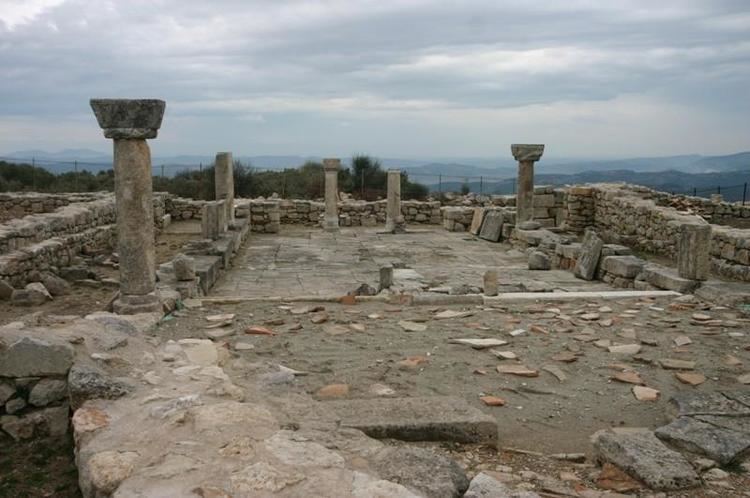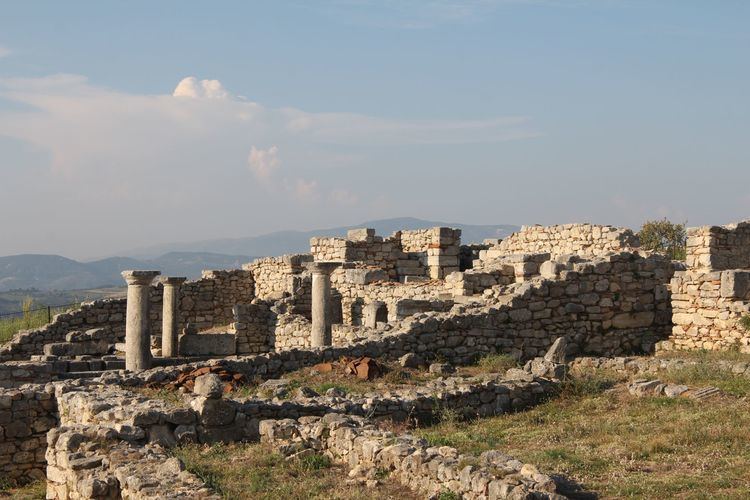Type Settlement Period Byzantine Empire | Region Illyria | |
 | ||
Location Hekal, Fier County, Albania Periods Hellenistic, Roman, Byzantine Cultures Illyrian, Greek, Roman, Byzantine Excavation dates 1978–1991, 2000-present Archaeologists Camillo Prashniker, Neritan Çeka, Skënder Muçaj, Jean-Pierre Sodini, Pascale Chevalier, Nicolas Beaudry | ||
Byllis
Byllis (Ancient Greek: Βύλλις or Βουλλίς) was an ancient city located in the region of Illyria. The remains of Byllis are situated north-east of Vlorë, 25 kilometers from the sea in Hekal, Fier County, Albania.
Contents
- Byllis
- Archaeological park byllis illyrian empire albania
- The city
- League of the Bylliones
- Roman and Byzantine rule
- Association with see of Apollonia
- References

Stephanus of Byzantium mentions Byllis as a seaside city (erroneously) in Illyria and its foundation legend, according to which the city was built by Myrmidons under Neoptolemus, returning from the Trojan War, a tradition confirmed by numismatics.

The Bylliones are first attested in the mid-4th century BC, in the description of the geographer Pseudo-Scylax, and also asking the oracle of Dodona to which god they should sacrifice in order to ensure the safety of their possessions. The archaeological attestation of the city is possible as far back as the second half of the 4th century BC and was later conquered by Pyrrhus. According to another view, Byllis was found by king Pyrrhus of Epirus.

Byllis received sacred Greek envoys, known as theoroi during the early 2nd century BC, indicator of the city's Greek character.

Archaeological park byllis illyrian empire albania
The city

Byllis, being a Greek-speaking city, on the borders of Illyria and Epirus, had its own stadium and theatre during the Hellenistic era. About its foundation it has been suggested that Byllis was founded by Greek settlers, though the fact that it had a mixed population is attested by the Illyrian names of officials. The city had its own coinage which was different from that of the tribe of the Bylliones. M. B. Hatzopoulos believes that Byllis is the northernmost non-colonian Greek city in the region.

The walls of Byllis were 2,200m long, enclosing 30 hectares of a plain atop a hill 524m above sea level. There were 6 gates in the city walls. The road coming from Apollonia passed through two of them, crossing Byllis in the direction of the narrows of gorges of the Vjosa river on the way to Macedonia or those of Antigonia in the direction of Epirus. In 2011 during a road reconstruction near the archaeological park found in the site a statue of the Hellenistic era, which may depict an Illyrian soldier or a war deity, was discovered. However, there is little point in proposing an Illyrian label for city in which language, institutions, officials, onomastics, city-planning and fortifications were Greek.
League of the Bylliones
The League (Koinon) of the Illyrian tribe of the Bylliones (Ancient Greek: Κοινὸν Βυλλίων), which had been hellenized to a degree and was bilingual, was a coalition of one or two poleis, as attested after 232 BC. The league was restricted to Byllis and Nikaea, and Byllis considered Nikaia as one of its demes. Nikaia was a member of the league, as a 2nd-century BC inscription indicates. The only attestation of the city as polis is in the work of Stephanus of Byzantium in the 6th century, On the other hand, the citizens of Byllis were called Byllideis (Greek: Βυλλιδεῖς).
Roman and Byzantine rule
Under the Roman Empire, Byllis became part of the province of Epirus Nova. The walls of Byllis carry more than four inscriptions with details regarding their construction by the engineer Victorinus, as ordered by Emperor Justinian I (483-565).
Association with see of Apollonia
One of the participants in the Council of Ephesus in 431 was a Felix who signed once as Bishop of Apollonia and Byllis, at another time as Bishop of Apollonia. Some assume that the two towns formed a single episcopal see, others suppose he was, strictly speaking, Bishop only of Apollonia, but was temporarily in charge also of Byllis during a vacancy of that see. At the Council of Chalcedon in 451, Eusebius subscribes simply as Bishop of Apollonia. In the letter of the bishops of Epirus Nova to the Byzantine Emperor Leo I in 458, Philocharis subscribed as Bishop of what the manuscripts call "Vallidus", and which editors think should be corrected to "Byllis". Whether Philocharis is to be considered Bishop also of Apollonia depends on the interpretation of the position of Felix in 431.
The Annuario Pontificio lists Apollonia as a titular see, thus recognizing that it was once a residential diocese, a suffragan of the archbishopric of Dyrrachium. It grants no such recognition to Byllis.
